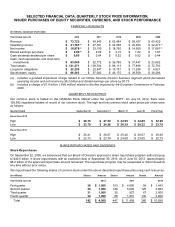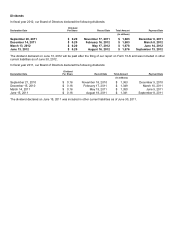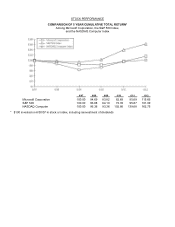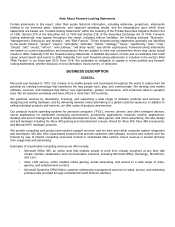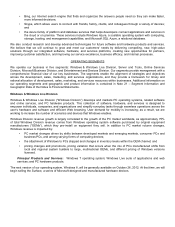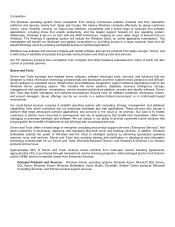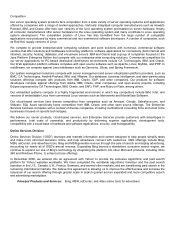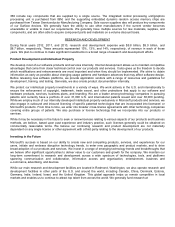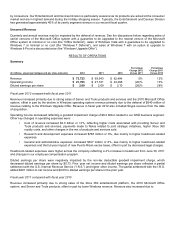Microsoft 2012 Annual Report Download - page 14
Download and view the complete annual report
Please find page 14 of the 2012 Microsoft annual report below. You can navigate through the pages in the report by either clicking on the pages listed below, or by using the keyword search tool below to find specific information within the annual report.
360 include key components that are supplied by a single source. The integrated central processing unit/graphics
processing unit is purchased from IBM, and the supporting embedded dynamic random access memory chips are
purchased from Taiwan Semiconductor Manufacturing Company. Sole source suppliers also will produce key components
of our Surface devices. We generally have the ability to use other manufacturers if the current vendor becomes
unavailable or unable to meet our requirements. We generally have multiple sources for raw materials, supplies, and
components, and are often able to acquire component parts and materials on a volume discount basis.
RESEARCH AND DEVELOPMENT
During fiscal years 2012, 2011, and 2010, research and development expense was $9.8 billion, $9.0 billion, and
$8.7 billion, respectively. These amounts represented 13%, 13%, and 14%, respectively, of revenue in each of those
years. We plan to continue to make significant investments in a broad range of research and development efforts.
Product Development and Intellectual Property
We develop most of our software products and services internally. Internal development allows us to maintain competitive
advantages that come from closer technical control over our products and services. It also gives us the freedom to decide
which modifications and enhancements are most important and when they should be implemented. We strive to obtain
information as early as possible about changing usage patterns and hardware advances that may affect software design.
Before releasing new software platforms, we provide application vendors with a range of resources and guidelines for
development, training, and testing. Generally, we also create product documentation internally.
We protect our intellectual property investments in a variety of ways. We work actively in the U.S. and internationally to
ensure the enforcement of copyright, trademark, trade secret, and other protections that apply to our software and
hardware products, services, business plans, and branding. We are a leader among technology companies in pursuing
patents and currently have a portfolio of over 31,000 U.S. and international patents issued and over 38,000 pending.
While we employ much of our internally developed intellectual property exclusively in Microsoft products and services, we
also engage in outbound and inbound licensing of specific patented technologies that are incorporated into licensees’ or
Microsoft’s products. From time to time, we enter into broader cross-license agreements with other technology companies
covering entire groups of patents. We also purchase or license technology that we incorporate into our products or
services.
While it may be necessary in the future to seek or renew licenses relating to various aspects of our products and business
methods, we believe, based upon past experience and industry practice, such licenses generally could be obtained on
commercially reasonable terms. We believe our continuing research and product development are not materially
dependent on any single license or other agreement with a third party relating to the development of our products.
Investing in the Future
Microsoft’s success is based on our ability to create new and compelling products, services, and experiences for our
users, initiate and embrace disruptive technology trends, to enter new geographic and product markets, and to drive
broad adoption of our products and services. We invest in a range of emerging technology trends and breakthroughs that
we believe offer significant opportunities to deliver value to our customers and growth for the company. We maintain our
long-term commitment to research and development across a wide spectrum of technologies, tools, and platforms
spanning communication and collaboration, information access and organization, entertainment, business and
e-commerce, advertising, and devices.
While our main research and development facilities are located in Redmond, Washington, we also operate research and
development facilities in other parts of the U.S. and around the world, including Canada, China, Denmark, Estonia,
Germany, India, Ireland, Israel, and the United Kingdom. This global approach helps us remain competitive in local
markets and enables us to continue to attract top talent from across the world. We generally fund research at



